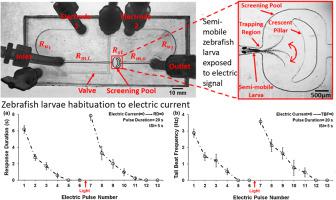Sensors and Actuators A: Physical ( IF 4.6 ) Pub Date : 2021-09-05 , DOI: 10.1016/j.sna.2021.113070 Arezoo Khalili 1 , Ellen van Wijngaarden 1 , Georg R. Zoidl 2 , Pouya Rezai 1

|
We previously showed that electric current induces zebrafish larvae to move towards the anode pole along a microchannel. For a larva with a fixed head and a moving tail, we observed that the response to electricity depended on the current magnitude. The effects of electric signal direction, voltage magnitude and habituation to repeated exposures to electric pulses were not characterized. Here, this knowledge gap was addressed by exploiting them in a microfluidic device with a head-trap to immobilize a zebrafish larva and a downstream chamber for tail movement phenotypic characterization based on response duration (RD) and tail beat frequency (TBF). We first assessed larvae’s response to electric current direction (at 3 µA) and voltage magnitude. Changing the current direction significantly altered the RD and TBF with long and low-frequency responses seen when the anode was positioned at the larvae’s tail. The electric voltage had a significant effect on larvae’s locomotion with long RD and low TBF observed at 5.6 V in the range of 1.3–9 V. We also demonstrated that the zebrafish locomotor response to repeated 3 µA current pulses diminished with dependency on the interstimulus interval. However, the diminished response was fully recovered after a 5-min resting period or introduction of a novel light stimulus (i.e., habituation-dishabituation strategy). Therefore, electric response suppression in zebrafish was attributed to the habituation as a form of non-associative learning. Our microfluidic platform has a broad application potential in behavioral neuroscience to study cognitive phenotypes, fundamental studies on the biological roots of electric response, and in pharmacological screening.
中文翻译:

斑马鱼幼虫对电信号的反应和习惯:在微流体装置中研究电压、电流和脉动的影响
我们之前表明,电流会诱导斑马鱼幼虫沿着微通道向阳极移动。对于头部固定、尾部移动的幼虫,我们观察到对电力的反应取决于电流大小。没有表征电信号方向、电压幅度和习惯对重复暴露于电脉冲的影响。在这里,通过在带有头部陷阱的微流体装置中利用它们来固定斑马鱼幼虫和下游室,以根据响应持续时间 (RD) 和尾拍频率 (TBF) 进行尾部运动表型表征,从而解决了这一知识差距。我们首先评估了幼虫对电流方向(3 µA)和电压幅度的反应。改变电流方向显着改变了 RD 和 TBF,当阳极位于幼虫的尾部时,可以看到长而低频的响应。电压对幼虫的运动有显着影响,在 5.6 V 观察到 1.3-9 V 范围内的长 RD 和低 TBF。我们还证明斑马鱼对重复 3 µA 电流脉冲的运动响应随着对刺激间隔的依赖而减弱. 然而,在 5 分钟的休息期或引入新的光刺激(即习惯-去习惯策略)后,减弱的反应完全恢复。因此,斑马鱼的电反应抑制归因于作为一种非联想学习形式的习惯化。


























 京公网安备 11010802027423号
京公网安备 11010802027423号